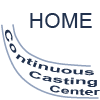(NSF) GOALI: Operational Reconfigurability of Constrained Moving-Boundary Processes through Agile Motion Planning with Application to Steel Continuous Casting Background.
J. Bentsman, R. O'Malley, B.G. Thomas, H. Castillejos, V. Natarajan, Y. Orlov, B. Petrus, N. Ross, K. Xu, Z. Chen, P. Duvvuri
National Science Foundation CMMI 1300907, Continuous Casting Consortium
National Science Foundation Support
CMMI 1300907
6/15/13 to 5/31/16
NSF Program Director: Massimo Ruzzene, (703) 292-2443
Former NSF Program Director: George Chiu, (703) 292-5365
NSF Grants Official: Kishna S. Ford, (703) 292-4370
Project Summary
Background
Processes with moving boundaries are pervasive in modern technology and environment, including crystal growth, solid and liquid burning, and multiple forms of melting and solidification. Their operation, however, is highly nontrivial due to difficulty in both synthesizing model-based feedback control laws for these processes and timely generating optimized motions and commands that these control laws are expected to enforce on the process. The first task has been successfully addressed by the PIs for a Stefan equation. However, rigorous generic methodology for the second task, referred to as agile motion planning, is currently lacking for this class of systems. If developed, it would permit a paradigm shift in important areas, such as continuous steel casting where instead of aiming to control temperature, efforts could focus on optimizing actual operational goals while maintaining product quality. In continuous steel casting both proper surface temperature profile and speed are crucial to avoid cracks, which develop due to stress concentration at austenite grain boundaries combined with detrimental precipitates formation, and whales - large strand bulges that develop under ferrostatic pressure when the liquid core of the solidifying steel strand extends past the containment zone. Thus, agile motion planning algorithms could realize one or more of the following steel casting objectives: 1) Pacing Mode – balancing throughput to maximize continuous-casting sequence length, 2) Maximum Productivity Mode - maximizing caster throughput, 3) Time Conservation Mode - maximizing casting time to allow operating units to stay linked, and 4) Energy Conservation Mode - maximizing the slab internal energy to lessen reheating costs; all under constraints of avoiding quality problems: internal cracks, surface cracks, and whale formation. The fundamental obstacles include better modeling of heat transfer during spray cooling with complexities of water-air-mist interaction, droplet formation, impact patterns, multiphase fluid flow, film boiling, and transient hysteresis effects, analytical coupling of these phenomena to shell thickness and crack formation, and use of the resulting generally nonsmooth models to synthesize reference motions that satisfy production objectives with no steel quality loss. The effort provides the command structure to
recently developed control strategies for tracking surface/internal temperature and solidification front.
Objectives
It is proposed to attain the paradigm shift described by pursuing the following objectives:
1) improve dynamic steel casting process model to be used in motion planning: significantly more precisely characterize heat transfer transient behavior during spray cooling by integrating results from new laboratory measurements, production data, model predictions, and targeted plant experiments.
2) clearly delineate static and dynamic constraints on the steel casting model behavior: develop dynamic crack-prediction capability, including both internal and surface cracks.
3) create the next generation of 1D and 2D motion planning algorithms for nonsmooth systems with moving boundaries under constraints: use novel rigorous mathematical formulation that incorporates dynamic equation kernels and static and dynamic constraints into optimization procedures to develop fast optimal motion planning techniques for systems with moving boundaries, focusing on steel casting.
4) apply, test, and refine novel motion planning algorithms for steel casting using real-time simulator.
Scientific Contributions and Intellectual Merit
Theoretical nonsmooth optimization results for systems with moving boundaries will be established, and on their basis novel real-time motion planning algorithms for nonsmooth moving boundary systems under constraints will be created. These algorithms will be applied to compute the optimal desired temperature/speed setpoint profiles for the steel casting strand under realistic operational objectives, providing a paradigm shift in continuous steel casting.
Broader Impact
Rigorously optimizing operation of moving boundary processes throughout modern technology is likely to have dramatic economic and environmental impacts. For example, improving steel casting process operation through rigorous setpoint design to achieve even a one percent reduction in yield loss would save about $150 million per year, while optimizing cooling conditions with better motion planning to conserve just 10% more of the internal strand energy would produce $350 million per year savings during reheating. Manufacturing with moving boundary process characteristics lies at the core of modern technology, and improvement even in a single such process - steel casting - will lead to noticeable benefits to the society due to ongoing rise of continuous-cast steel produced each year in this country. Student researchers will master and broadly disseminate expertise and commercialize the results.
Publications
Conference Papers and Presentations
Petrus, B., J. Bentsman, and B. G. Thomas, “Application of Enthalpy-Based Feedback Control Methodology to the Two-Sided Stefan Problem”, American Control Conference 2014. Portland, Oregon, USA, pp. 1015-1020.
Petrus, Bryan, Danny Hammon, Megan Miller, Bob Williams, Adam Zewe, Zhelin Chen, Joseph Bentsman, Brian G. Thomas, “New Method to Measure Metallurgical Length and Application to Improve Computational Models”, AISTech 2015, Cleveland, OH, May 4-6, 2015, Assoc. Iron Steel Technology, Warrendale, PA, pp. 3238-3248.
Journals
Maldonado, Yadira G., Claudia Barraza de la P., Sergio Rodríguez A., A. Humberto Castillejos E. and Brian G. Thomas, “Estimation of Time-Temperature-Transformation Diagrams of Mold Powder Slags from Thermo-analysis of Non-Isothermal Crystallization”, Metallurgical and Materials Transactions B, 46B (1), pp. 286-303, 2015.
|

